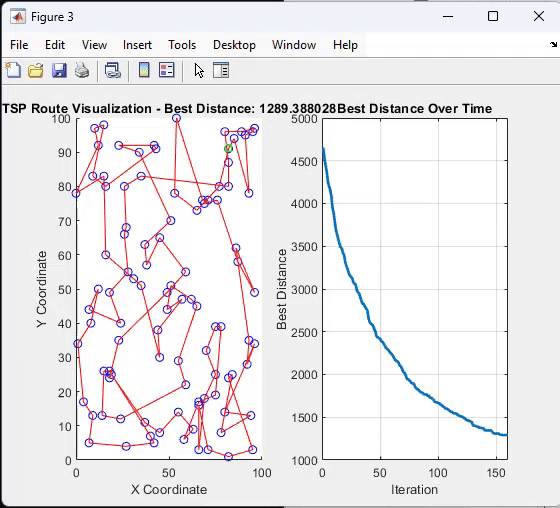BEE-TSP-Optimizer
A hybrid Python/C++/Matlab implementation of the Bee Algorithm for solving the Traveling Salesman Problem. Features interactive visualizations, performance optimizations, and customizable colony parameters to efficiently find near-optimal routes.
Overview
This project implements the Bee Colony Optimization algorithm as a metaheuristic solver for the classic Traveling Salesman Problem (TSP). Instead of using standard approaches like Branch and Bound or Dynamic Programming, I explored nature-inspired computing through the Bee Algorithm—a population-based search technique that mimics honeybee foraging behavior to efficiently navigate complex solution spaces.
The repository provides a complete ecosystem for TSP experimentation:
- A Python implementation with visualization capabilities for research and teaching
- A high-performance C++ version optimized for large-scale problems and benchmarking
- A MATLAB demonstration script for animated visualization of the search process
The hybrid approach allows for flexibility: rapid prototyping and interactive visualization in Python, with the option to scale to the C++ implementation for production use. Both implementations share the same algorithmic foundation but are optimized for their respective environments.
The solver features adaptive neighborhood search techniques (2-opt, swap operators) that balance exploration and exploitation through carefully tuned colony parameters. The visualization modules provide real-time feedback on the algorithm’s convergence progress, illustrating how different bee types (scouts, followers, elites) collaborate to find increasingly optimal tours.
Tech Stack
The project leverages several technologies to balance performance, flexibility, and visual feedback:
- Languages: Python 3.10+, C++17, MATLAB R2023b
- Core Libraries:
- Python: NumPy (for vectorized operations), Matplotlib (visualization), pandas (data handling)
- C++: Standard Library with custom data structures
- Utilities: tqdm (progress bars), structlog (structured logging), tabulate (formatted output)
- Build Tools: g++ compiler (with -O3 optimization), Python setuptools
- Visualization: Matplotlib for interactive plots, MATLAB for animated demonstrations
Getting Started
- Clone the repository:
git clone https://github.com/Nicolas2912/BEE-TSP-Optimizer.git cd BEE-TSP-Optimizer - Python setup:
pip install -r requirements.txt - C++ setup:
cd cpp g++ main.cpp TSP.cpp Bee.cpp -std=c++17 -O3 -o bee_tsp
Usage
Python Implementation
python BeeAlgorithm.py \
--ns 75 --nb 55 --ne 15 --nrb 25 --nre 25 \
--routeLen 50 --iterations 100 \
--visualize True --visualize_final True
Parameters explained:
ns: Number of scout bees that explore the solution space (default: 75)nb: Number of best sites selected for neighborhood search (default: 55)ne: Number of elite sites given priority for intensive exploration (default: 15)nrb: Recruited bees for best sites - controls exploitation breadth (default: 25)nre: Recruited bees for elite sites - controls exploitation depth (default: 25)routeLen: Number of cities in the problem instance (default: 50)iterations: Maximum search iterations (default: 100)visualize: Enable/disable real-time visualization (default: True)visualize_final: Plot the final optimized tour (default: True)
C++ Implementation
- Compile:
cd cpp g++ main.cpp TSP.cpp Bee.cpp -std=c++17 -O3 -o bee_tsp - Run with default parameters:
./bee_tsp - Or with custom parameters:
./bee_tsp 75 55 15 25 25 50 100(Parameters follow the same order as the Python implementation)
MATLAB Animation
Open MATLAB and run:
main
Set animate = true in the script to watch the colony explore the TSP landscape in real-time.
Architecture & Components
Core Modules:
BeeAlgorithm.py: Main Python implementation with parameter parsing, colony management, and visualization logiccpp/Bee.cpp,cpp/Bee.h: C++ implementation of the bee agent with local search operatorscpp/TSP.cpp,cpp/TSP.h: Problem modeling, distance calculations, and solution validationcpp/main.cpp: Entry point with command-line argument handling
Utilities:
utils/distance_matrix.py: Efficient calculation of city-to-city distancesutils/csv_handler.py: Export results for external analysisutils/visualization.py: Real-time and final tour plotting functions
Experimental Assets:
examples/: Sample coordinate files for benchmark TSP instancessolutions/: Pre-computed tours for comparison and validation
Testing:
tests/test_solutions.py: Unit tests comparing route lengths against known benchmarkstests/test_operators.py: Validation of local search operators
Challenges & Solutions
Several technical challenges emerged during development:
-
Efficient Neighborhood Search: For large problem instances, the neighborhood search became a bottleneck. I optimized this with a 2-opt implementation that caches distance calculations, reducing computational overhead.
-
Cross-language Implementation: Maintaining consistency between Python, C++, and MATLAB implementations required a unified abstract model. I developed a common interface specification that all implementations follow, ensuring algorithm behavior remains consistent across languages.
What I Learned
-
Metaheuristic Algorithm Design: Implementing the Bee Algorithm deepened my understanding of population-based search strategies. Particularly insightful was seeing how simple rules of agent behavior can lead to emergent problem-solving capabilities across diverse TSP instances.
-
Optimization Techniques: The project provided practical experience in algorithmic optimization, from vectorizing operations in NumPy to leveraging optimization techniques in C++. The most significant performance improvements came from translating the neighborhood search logic into C++.
-
Multi-language Development: Working across Python, C++, and MATLAB reinforced the importance of consistent interfaces and modular design. Each language offered different strengths: Python for rapid development and visualization, C++ for raw performance, and MATLAB for mathematical analysis and animation.
-
Visualization as a Debugging Tool: Real-time visualization proved invaluable for understanding algorithm behavior and identifying issues.
Improvements I’d Like to Make
Here are enhancements planned for future iterations:
-
GPU Acceleration: Implement CUDA kernels for parallel neighborhood search operations, potentially yielding 10-100x speedup for large problem instances.
-
Web Dashboard: Create an interactive web interface for experimenting with parameters and visualizing results in real-time.
-
Problem Extensions: Adapt the solver for variants like the Vehicle Routing Problem (VRP), Multiple TSP, and Prize-collecting TSP.
Screenshots
